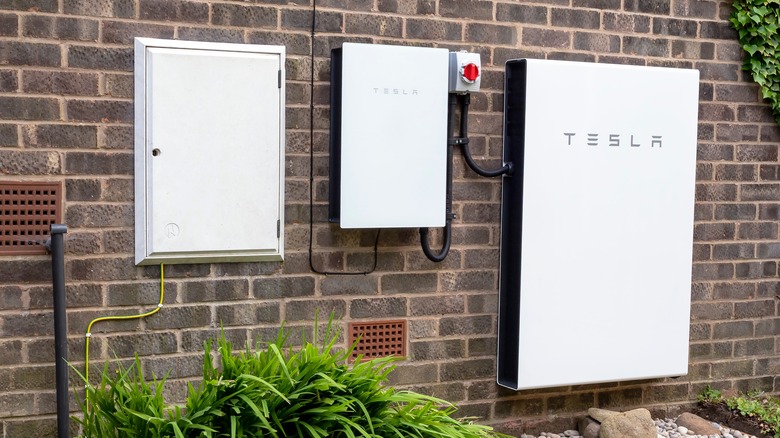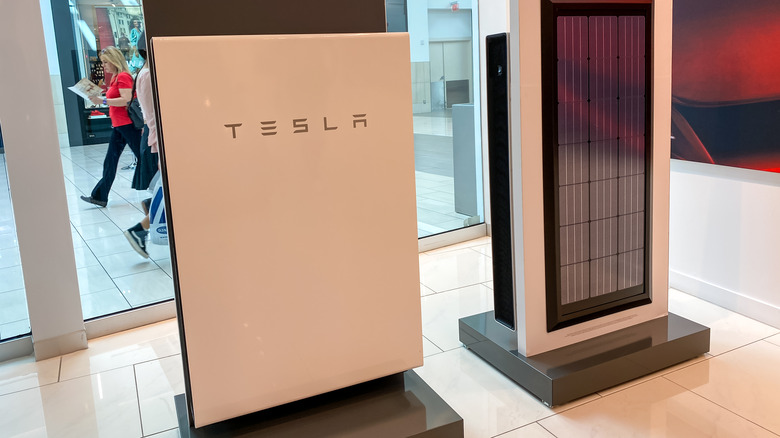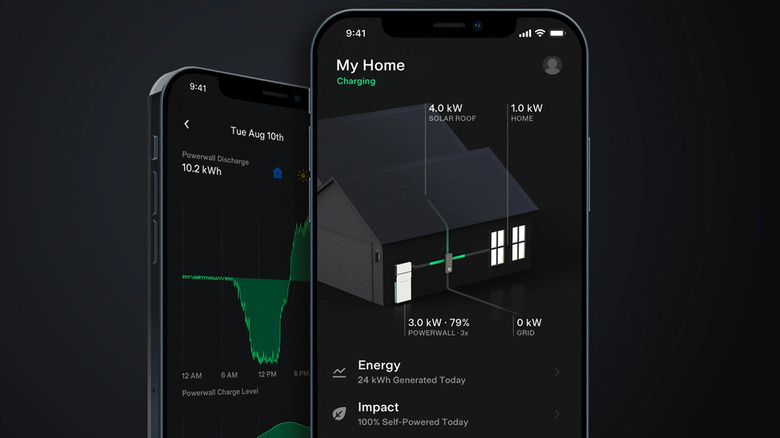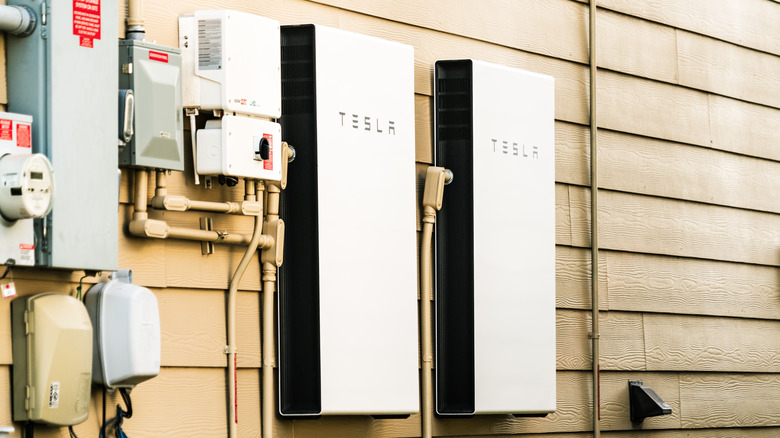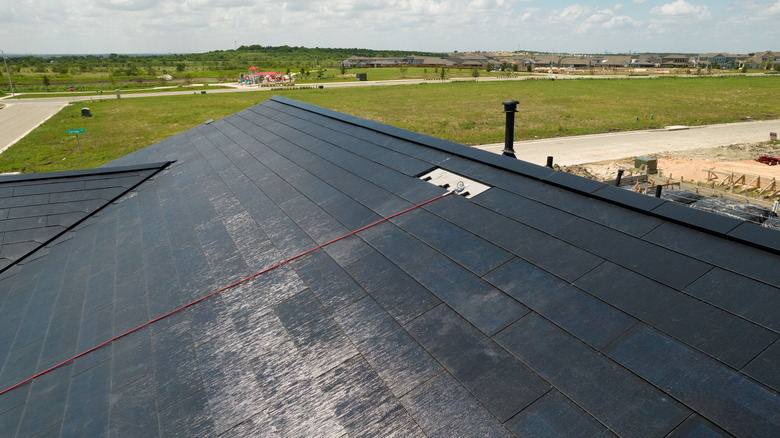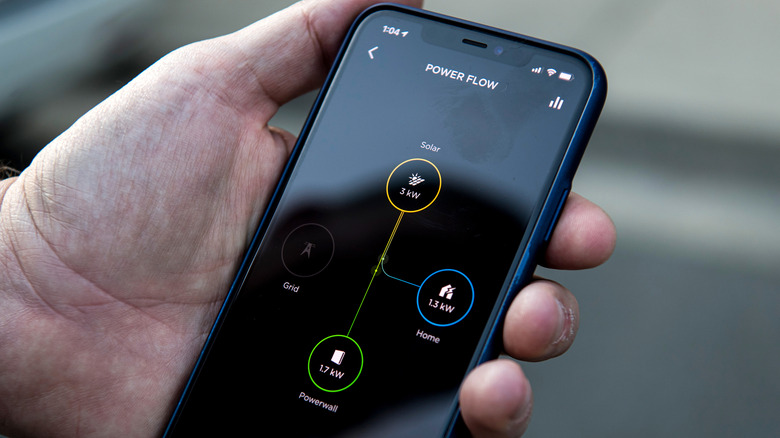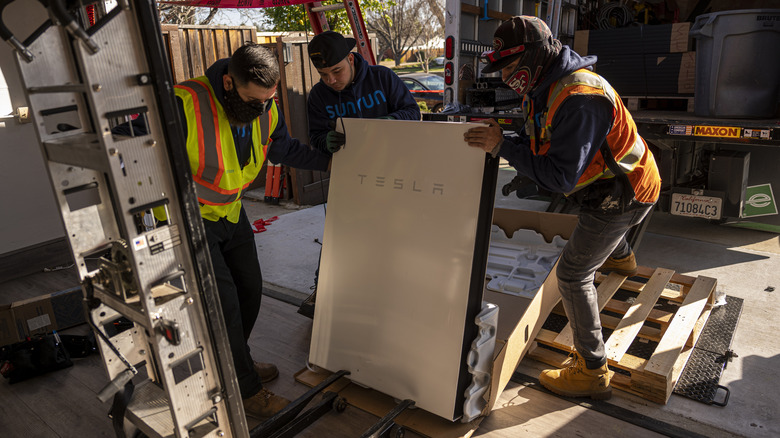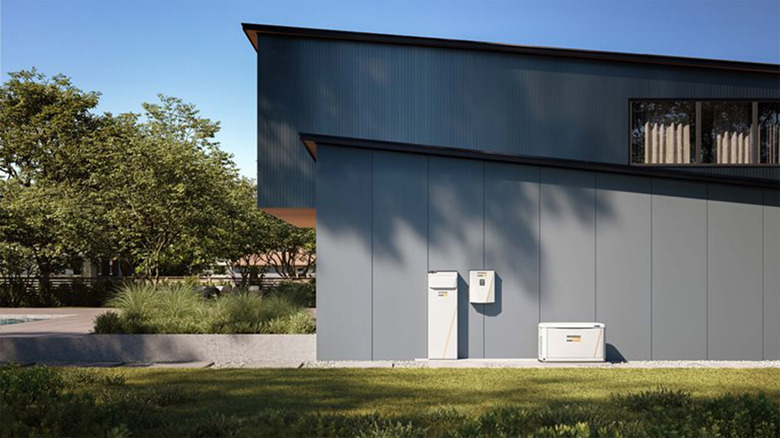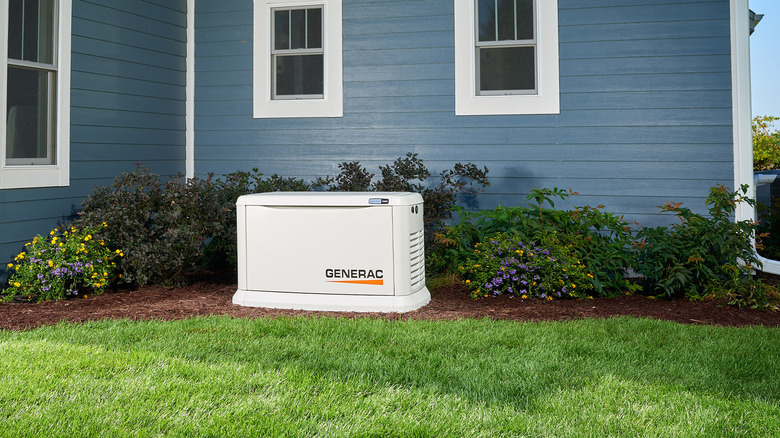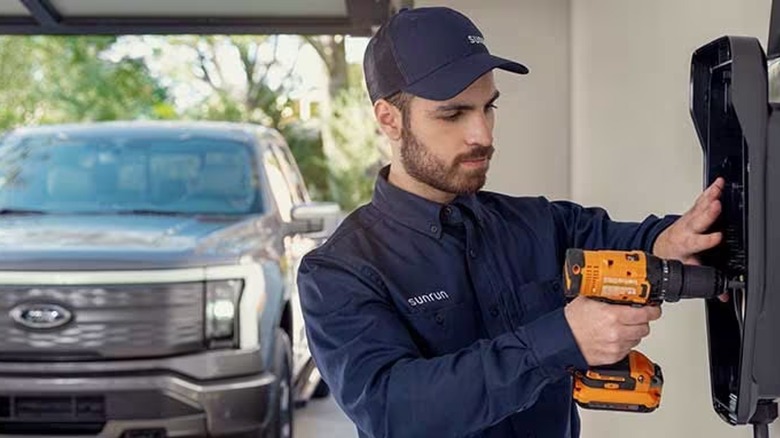Tesla Powerwall: 5 Pros And 5 Cons Of The Home Energy System
The Tesla Powerwall is a battery backup system for residential homeowners that you can buy directly from Tesla or from an installer. It houses a 13.5 kWh battery which should power a home for between one and two days according to Tesla — not bad numbers. Tesla prefers that you integrate a Tesla Powerwall with a Tesla Solar Home system, whether it's the company's solar panels or the Solar Roof, but you can still use this battery without a solar system if you prefer. In that case, it'll charge off of the power in your home and then activate when you lose power.
The Powerwall has a bunch of great features. It looks good, it's easy to control, and you can buy one with and without a power inverter to better augment your setup. Today's Powerwalls are technically the second generation. The first-generation Powerwalls are discontinued which means that, despite Tesla's naming scheme, you only have access to the newest version of the Powerwall.
Another thing to keep in mind is that the installation wait times can take a while. Owners have told stories of waits that can take as long as six to 12 months. However, it seems many installs are completed within a few months. With all that in mind, let's take a look at some other pros and cons of the Tesla Powerwall.
Pro: It's a competent battery backup system
Let's start with the most obvious pro — the Tesla Powerwall works, and it works well. It's a reasonably sized unit that measures a little under four feet tall, two and a half feet wide, and about six inches deep. The small stature should make it easy to integrate almost anywhere in or around a house or even an apartment. The power capacity is about average for a house battery so you're not missing out if you go with this over a competitor. You can also connect up to ten Powerwalls together for 135kWh of energy storage, which is enough to power a home for a week or more.
There are other basic benefits as well. The Powerwall is an AC-coupled battery, so it can be easily integrated into existing solar panel systems. That makes it simple for consumers who already went through that process and just need a battery to store some energy. You can also pair it with Tesla's Solar Inverter, which is excellent in its own right.
The Powerwall also comes with its own app, although this isn't the most unique feature these days. You can use it to check how much energy you have stored, how much you've consumed, and other metrics.
Pro: Time of Use scheduling can save you money
One of the better traits of Tesla Powerwalls is its versatility. The app has a function that lets you use battery power instead of grid power during scheduled times of the day. This can help circumvent things like Time of Use (TOU) pricing. TOU is a practice by electrical companies where they charge customers higher rates during peak hours of the day. For example, a utility provider might charge more for electricity between the hours of 4 p.m. and 9 p.m. because that's when most people are home and using electricity. It can lead to high energy bills, especially during the summer when people run their air conditioners.
Tesla has a solution for this if you own a Powerwall. The app lets you schedule it so that you use energy from your Powerwall during the peak hours of the day. The battery then recharges during the off-peak hours, which can save you a bunch of money. The Powerwall isn't the only home energy storage product capable of this, but its excellent app helps make it very easy for consumers to configure.
Those with solar panels can also avoid pulling off of the grid during the times of the day when electricity is the most expensive. It's just an all-around win for the Powerwall. It may take a long time before this practice pays off your Powerwall in energy savings, but every little bit helps.
Pro: Tesla Powerwalls have excellent warranties
Tesla backs up their Powerwalls with one of the best warranties available for home backup batteries. Each Powerwall comes with a 10-year warranty that offers an unlimited number of charge cycles. The 10-year part of the warranty isn't terribly special. Most competitors do 10-year or 15-year warranties. The lack of charge cycle restrictions, on the other hand, is much more impressive.
This guarantee means you can discharge and recharge the battery a nearly endless number of times and still get a repair or replacement under warranty if your Powerwall breaks down within 10 years. This warranty is only available in the U.S. and you must purchase the Powerwall directly from Tesla or a Tesla-approved installer for it to apply.
To be fair to the competition, warranties in this space are generally good all around. Most competitors give you 10 years with 10,000 charge cycles. That's about 83 charge cycles per month or about two and a half charge cycles per day. Most people shouldn't hit those kinds of numbers even with heavy usage. Those who only use battery backups for power outages likely never will. Even so, Tesla's unlimited cycle warranty is an extra step that delivers complete peace of mind. You can use it as often as you want to without worrying about voiding the warranty.
Pro: It works well with Tesla solar products
Tesla gives consumers the option to bundle the Powerwall with their existing solar panel and Solar Roof products, which are some of the better-looking panels you can get. They are low profile, integrate well with existing roofs, and are all black to make it harder to see the grid pattern in the panel. Additionally, Tesla price matches competitors in the U.S., which makes its products among the cheapest solar panel systems. The panels boast approximately a 20% efficiency rate, which is well within the average for the solar panel industry.
The Solar Roof is also a neat product. It replaces your roof entirely with small, shingle-sized solar panels. Once installed, it looks like a glassy version of a normal roof. This means you get the benefits of solar panels on your roof without the often gaudy look of traditional solar panels, with the only tradeoff being lower efficiency when compared to traditional solar panel systems.
In addition, both of Tesla's systems come with a 25-year warranty from Tesla. By bundling the solar system with the Powerwall, you can buy all of your solar products from a single manufacturer. That's one source for installation along with one source for warranty repairs or replacements. You may even save some money on installation costs if you do everything at once.
Pro: Powerwalls get software updates to stay relevant
Tesla brings some of its most successful practices from its cars to its solar equipment, including firmware updates. Tesla Powerwall updates can improve performance and stability, fix bugs, and help prevent failures. The company can also tweak things like cold weather performance, utility grid connection behavior, and other device behaviors.
Tesla's update page shows that the company was averaging one update per month up through March of 2023, although some of those were for the official app and not necessarily the Powerwall device. However, since the app and the Powerwall are part of the same system, you'll see some overlap whenever updates go out.
These days, the Powerwall firmware appears to be solid. Modern updates have short changelogs with just a couple of minor things here and there. Tesla's February 2023 update featured improved open circuit breaker detection and better Spanish support for billing statements in the app. This is a good sign because it means these software updates have improved the Powerwalls to the point where only minor adjustments need to be made.
Con: Powerwalls are expensive
The first big detractor of Powerwalls is the price — these things go for $8,700 a pop.
However, you can get minimal discounts for ordering more than one. Tesla's website has three listed at $23,700, which equates to $7,900 each. Still, installation by an approved technician is going to boost that cost to approximately $10,000 per unit. Rates vary depending on your location, how many you order, and whether or not it's included in a full Tesla solar system installation. There are federal tax credits in the U.S. to help offset the cost, but you have to wait until tax time to get that money back. Some states have rebates and incentives as well, although these obviously aren't exclusive to Tesla and will work for almost any solar system.
To be fair to Tesla, competitors are also expensive. The Generac PWRcell, SunPower SunVault, sonnenCore batteries, and Panasonic EverVolt batteries all start around $10,000 and can range up to $15,000 or more for similarly sized batteries before installation costs are factored in. The Sonnen EcoLinx can cost north of $35,000.
There simply isn't a large enough market to bargain shop for whole-home backup batteries, but at least Tesla batteries are cheaper than many others. Unfortunately, cheaper doesn't mean much in this instance, especially if you intend on buying multiple batteries to string together.
Con: Competitors have features that Powerwalls don't
There are several competitors to the Tesla Powerwall. Each one has its own set of unique features, just as the Powerwall does, but different people have different needs. As such, one of the competitor's options may have features or costs that are more in line with someone's particular use case. With the Powerwall, you get software updates, a competent companion app, ease of use, and a solid overall battery experience that can scale up to ten Powerwalls connected together. That's not half bad, but it's also not the only option.
For instance, the Generac PWRcell has modular batteries. That means you can buy a PWRcell and expand it later at your convenience. Modules tend to go for about $2,000, which isn't cheap. However, it gives you the option to buy small now and then expand later when you can afford it. The PWRcell's maximum capacity is 18 kWh, which is not only a larger overall capacity per unit than the Powerwall but offers added flexibility that gives homeowners room to grow.
Many competitors have multiple sizes, as well. The SunPower SunVault has units that are 13 kWh or 26 kWh, and there are other features aside from size. For instance, LG batteries can discharge almost their entire battery capacity at high efficiency. It's not a bad idea to surf around to see if other batteries work better for your use case.
Con: Competitors have bigger batteries
The Tesla Powerwall battery capacity is 13.5 kWh. You can stack up to 10 of them together for a grand total of 135 kWh. There isn't anything wrong with those numbers by any means — they just aren't the highest numbers you can achieve with home battery backups.
Most competitors have options that are larger on a per-unit basis than the Powerwall. Some competitors even have batteries capable of storing more energy than 10 Powerwalls linked together. Larger units are generally more expensive, but you are getting something for the extra money. The LG RESU16H Prime is a good, albeit tame, example. It features 16 kWh of energy storage. The Generac PWRcell can do up to 18 kWh per unit. Some manufacturers, like Sonnen and SunPower, can make units with 20 kWh of storage or more.
You can also stack most of these units up to two or three times, giving you plenty of energy storage while buying fewer units, and some of the numbers can get pretty insane. Perhaps the best example is the Panasonic EverVolt. It has a maximum capacity of 17.1 kWh if used in an AC-coupled system. That boosts to 102 kWh in a DC-coupled system, and you can stack three together for up to 306 kWh of power, the equivalent of 22 Powerwalls.
Tesla gives consumers a good combination of features and energy storage, but you can do better if all you want is raw storage capacity.
Con: Gas generators are cheaper for occasional use
Battery backups are great for a variety of reasons. The peace of mind of having power during an outage is probably the biggest one. Here's the thing. Backup batteries work best with a solar panel system. The flexibility of such a setup is its biggest asset, especially when dodging TOU rates. However, those without solar panel systems aren't going to get the most out of their backup batteries since those batteries charge using your house power anyway. For those folks, it might be smarter to go with a whole house generator instead of a battery backup.
Whole house generators use natural gas, propane tanks, or another fuel source to power your home during an outage. You don't need a whole solar panel setup to get the most out of one and it's also vastly less expensive, as they typically cost around $4,000 to $7,000, although you can buy higher capacity generators that cost more. Of course, they do depend on fossil fuels, which is not the most climate-friendly solution.
However, people on stable electrical grids only suffer power outages a few times a year for a few hours at a time, so most folks simply don't need a $10,000 battery pack charged up 365 days a year only to use half of one discharge every three or four months. You can get the same peace of mind during a power outage at half the cost if you go with a gas generator.
Con: EVs might join the party eventually
Electric vehicles are getting more plentiful and more popular every year, which means that car companies are innovating to include more new and useful features — such as the ability to charge or power other items using the vehicle's charging port.
The Ford F-150 Lightning is a great example of this. The truck comes with either 98 kWh or 131 kWh, depending on the trim. That's between seven and nine Tesla Powerwalls worth of power. The base Ford F-150 Lightning has an MSRP of $49,995. Seven Tesla Powerwalls costs well north of that before installation fees. While there are obviously pros and cons to comparing purpose-built batteries to EV trucks, the argument is there. It's cheaper to buy the truck and you can use trucks for a lot more than powering homes.
This kind of technology probably won't be available on every EV in the future, but manufacturers can't help but take notice. The Ford F-150 received great press during the 2021 Texas blackout when one owner used the hybrid version of the truck to power a refrigerator, a space heater, a toaster oven, and a few lights. Ford includes the ability to power a whole house through the charging plug on the latest models of the fully electric version, and other car manufacturers could theoretically add this functionality. Batteries are better at powering houses, but if all you need is emergency power during outages, using your EV isn't the worst idea.
